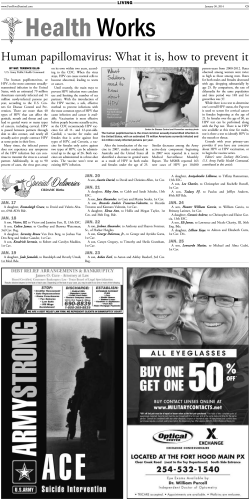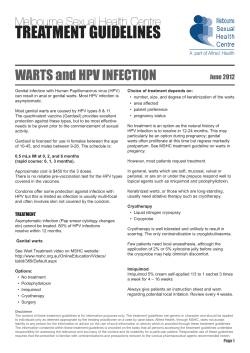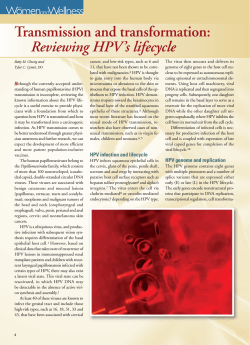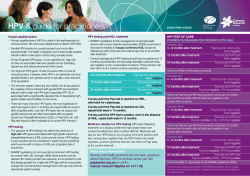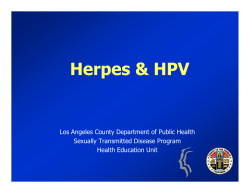
How to manage and communicate with patients about HPV? CHAPTER 11
International Journal of Gynecology and Obstetrics (2006) 94 (Supplement 1), S106---S112 www.elsevier.com/locate/ijgo CHAPTER 11 How to manage and communicate with patients about HPV? Suzanne M. Garland *, Michael A. Quinn KEYWORDS Human papillomavirus; Communication; Patients; Psychosocial aspects Abstract The whole concept of abnormal Pap smears and cervical cancer being due to an STI poses enormous challenges to the healthcare provider. The psychological and psychosocial sequelae of misinformation are potentially damaging both to the woman and her partner. There is a clear responsibility for the information around this to be simple, relevant, reassuring and comprehensible. Written information is invaluable. © 2006 International Federation of Gynecology and Obstetrics. Published by Elsevier Ireland Ltd. All rights reserved. 1. Introduction 1.1. Role of HPV in cervical cancer Human papillomavirus (HPV) infection of the genital tract is largely asymptomatic, although clinical manifestations are diverse. These range from benign, typically exophytic, “cauliflower-like” genital warts, otherwise known as condylomata acuminata, to dysplasia and, rarely, to cancer of the cervix, vagina, vulva, and/or anus. Genital HPV infection is the most common viral sexually transmitted infection (STI), yet cervical cancer for which HPV infection is a key etiological factor, is by comparison a rare disease. Most genital HPV infections are transient and asymptomatic, as natural immune surveillance usually clears HPV from infected epithelia. It is only in a small number of women, in whom infection with oncogenic HPV genotypes persists, that cervical intraepithelial neoplasia (CIN 2/3) devel- ops and, over several decades, may lead to cancer. Carcinogenesis requires additional genetic changes such as integration of the HPV genome into hostcell chromosomes, and may be facilitated by cofactors such as cigarette smoking, prolonged use of oral contraceptives, high parity, and other sexually transmitted infections, e.g., genital herpes simplex type 2 and/or Chlamydia trachomatis. How these co-factors contribute to the development of cervical cancer is not fully explained. Low-grade squamous intra-epithelial lesions (LSIL), also known as CIN 1, are caused by a transient, productive infection of the cervix by HPV, with a median duration of infection before clearance of infection by cell mediated immunity of approximately 6 months. The most common types of HPV found in low-grade intra-epithelial lesions are HPV genotypes 6, 11, 16, and 18 * Corresponding author. 0020-7292/$ --- see front matter © 2006 International Federation of Gynecology and Obstetrics. Published by Elsevier Ireland Ltd. All rights reserved. How to manage and communicate with patients about HPV? 1.2. External genital warts It is estimated globally, that about 10% of sexually active individuals will be diagnosed with external genital warts during their lifetime. External genital warts (EGWs) have an incubation period of 2 to 3 months (mean, 2.8 months; range, 3 weeks to 8 months), with an infectivity rate of 64%. Although genital warts are benign, with symptoms that range from itching, to secondary infection and bleeding, they cause considerable psychological distress as most patients find them distasteful and unsightly. The occurrence of EGWs has increased in the past few decades, making these lesions the commonest STI in many countries. The peak incidence of EGWs is found among women aged between 16 and 25 years, as is true for most STIs. Nearly all EGWs contain HPV types 6 or 11, and although they are in themselves benign, co-infection with highrisk types of HPV such as types 16 and 18 is extremely common. Consequently, it is not uncommon for women with EGWs to also have CIN. Surgical treatment for EGWs includes excision and/or ablation with cautery or laser vaporization. Medical methods use topical immune modulators, such as imiquimod, or toxic substances such as podophyllotoxin or bi-or tri-chloracetic acid. Both surgical and medical methods of treating EGWs have a significant failure rate and careful follow-up is important. Immunocompromised individuals are at greatest risk of recurrence post-treatment. 2. HPV vaccines HPV vaccines will be available in some countries in 2006 and phase 2 and 3 clinical trial data of prophylactic monovalent (16) [1], bivalent (16, 18) [2] and quadrivalent (6, 11, 16, 18) [3] HPV vaccines have been completed. The quadrivalent vaccine has been approved by the FDA and TGA (Therapeutic Drug Administration) in June 2006. The results so far have overwhelmingly shown efficacy in preventing not only transient and chronic cervical infection from the targeted HPV types, but also CIN 2/3 and external genital lesions caused by HPV (i.e., vulval intraepithelial neoplasia [VIN]), vaginal intraepithelial neoplasia (VAIN), and EGWs by the quadrivalent vaccine) [4]. 3. HPV DNA in clinical practice These encouraging data are certainly not matched by community knowledge about HPV infection, as the vast majority of women are either completely S107 unaware of its link with the development of cervical cancer, or confused and angry about it being a STI. It is urgent to redress this situation given the increasing use of HPV DNA testing in screening programs to triage women with equivocal Papanicolaou (Pap) smears; as a test of cure in women treated for precancerous changes; and because of the high likelihood of the introduction of prophylactic HPV vaccination in 2006. 4. Psychosocial aspects of Pap screening and of HPV DNA There are strong data emphasizing the usually negative experience of women who undergo Pap cervical cytology testing, and there is increasing information about the psychosocial and psychosexual implications of a diagnosis of HPV, which can have profound consequences for women, their partners, and their future as a couple. For instance, a recent study has demonstrated that irrespective of cytological status, women who test positive for HPV DNA are significantly more anxious and distressed than women who test negative, and feel significantly worse about their sexual relationships [5]. Furthermore, the style in which clinicians communicate the results after HPV testing and the mode of delivering the result also influence women' s psychological response to the diagnosis of HPV infection [6]. It is clear that the way in which information is presented is crucial to minimize the potentially negative impact of testing positive, so that women will continue to participate in screening programs [7]. Clinicians need to be aware that a positive test result for HPV may generate emotions identical to those following the diagnosis of any other STI. These include depression, anguish, anger, loss of self-esteem, and hostility toward the person believed to be the source of the infection [8]. Other causes of anxiety may arise, about the development of malignancy, for example, or the loss of fertility. 5. Women's knowledge of HPV In contrast, several recent studies help us understand women' s information needs regarding HPV infection [7,9---11]. One study from Australia conducted with women aged between 18 and 30 years showed that while many respondents did not understand the risk factors associated with HPV infection, i.e., the potential long-term complications of infection, including cervical cancer, they demonstrated good understanding of the reason for the Pap test and the meaning of an abnormal result [12]. Encour- S108 S.M. Garland, M.A. Quinn Box 1 Psychosocial key points • Most women (and men) have not heard • • • • about HPV Most women are unaware of the link between cervical cancer and HPV Most are unaware that genital HPV is transmitted sexually The diagnosis of HPV infection can have psychosocial and psychosexual outcomes Many women report trust in their health care practitioners when seeking information about HPV and potential vaccines agingly, while very few women had heard of that an HPV vaccine may soon be released, most stated they would approach their general practitioner for more information if one became available [12]. Moreover, in a recently conducted telephone survey carried out with a representative sample of 1100 women between the ages of 18 and 61 years randomly selected in Victoria, Australia, to investigate knowledge and understanding about cervical cancer, Pap tests, vaccination, as well as attitudes towards a proposed HPV vaccine, one half of the women (51%) had heard of HPV and most reported learning about HPV from the media [13]. The knowledge of these women was relatively high, although very few had ever been told they had HPV. Women reported high levels of trust in health care practitioners (particularly physicians and nurses) as sources of information and advice about HPV --- which suggests the importance that health care providers will have in developing health promotion and education programs [13]. 6. Community needs around HPV Overall, women need information about modes of transmission, methods of prevention and detection, likelihood of progression with and without treatment, infectivity to partners, period of progression to cancer, and possible effects on pregnancy and childbirth. Even though the sexually transmitted nature of HPV preoccupies mostly younger women, cancer risks seem greater as women age. The distinction between low- and high-risk HPV DNA genotypes is often poorly understood, and there is a clear need for women to know their own subtype of infection [10,14]. 7. Impact of the media Some of this confusion has been generated by the media, as more than 90% of media reports make no distinction between the viral types that cause genital warts and those that cause cancer. Moreover, the information that condom use is imperfect at preventing HPV infection is seriously lacking [15]. 8. Men's knowledge of HPV Not only is the information targeting women insufficient and often wrong, but men are usually neglected, both in the delivery of information and in studies about knowledge of HPV infection and impact of diagnosis. The need to provide both women and men with broader information has been acknowledged [16], and the doctor' s office is an ideal place to distribute information about HPV containing models and diagrams. The value of written information about HPV infection cannot be over emphasized, and the presence of a support person --- a partner, relative, or friend --- will undoubtedly improve retention of information. A list of websites with accurate information would be welcome, particularly for younger women. For those in developing country settings, appropriate means of health education need to be found that are culturally appropriate, and that provide information that is accessible and digestible. 9. Normalizing HPV It is important for patients to understand the ubiquitous nature of HPV infection and to de-stigmatize having an HPV infection. The clinical manifestation of HPV infection in a particular individual is a reflection of how that individual' s immune system has dealt with the infection and is not necessarily related to current or past sexual activity. It is possible to become infected with HPV after a single sexual encounter. It is the responsibility of the clinician to provide as much information as possible to the patient and to “normalize” the existence of genital HPV in many sexually active individuals. 10. Key points about HPV The keypoints about HPV are listed in Box 2. How to manage and communicate with patients about HPV? Box 2 S109 Key points about HPV • Low-grade squamous intraepithelial lesions (LSILs) represent the cytopathic effect of the virus on a cell but are not precancerous. The median duration of these lesions is 6 months or less. • Around 40 HPV genotypes selectively infect the genital area, and they are largely sexually • • • • • • transmitted. Some are low risk for cancer, genotypes 6 and 11 being the etiological agent for most external genital warts (EGWs). The incubation period for EGWs is about 3 months (6 weeks to 8 months) and the lifetime risk approximately 10%. Some HPV genotypes are high risk for cervical cancer and its precursor lesion, high-grade dysplasia (CIN 2/3 or HSIL), with HPV-16 and HPV-18 accounting for 70% of cervical cancers and HSILs, and 25% to 35% of LSILs. Persistent infection with high-risk HPV is necessary for the development of HSIL, which occurs earlier than previously realized following initial infection (e. g., 6 to 12 months after HPV-16 is detected). The median time from incident HSIL to microinvasive disease is 15 years. Genital HPV infection is largely transient & asymptomatic, with most being cleared within 9---15 months. Cervical cancer per se is a rare outcome from an infection with high-risk HPV. Prophylactic HPV vaccines (monovalent, bivalent, and quadrivalent) show 100% efficacy in women against persistent infection of vaccine-related HPV types. They protect as well against HSIL for the vaccine-related HPV types for at least 5 years. Quadrivalent vaccines are protective for external genital lesions (vulval intraepithelial neoplasia [VIN] and EGWs) as well as vaginal intraepithelial neoplasia [VAIN]. 11. Normalizing HPV 11.2. How long will I have this infection, and will it lead to cancer? 11.1. What is HPV and how did I get it? There are more than 100 types of human papillomaviruses, of which approximately 40 can infect the male and female genital tract. Some of these viruses can cause genital warts but most cause no symptoms, are transient, and will have no adverse effects for the woman or her partner. Well over 95% of HPV infections disappear within 18 months and only a small percentage persist to cause abnormal cells (CIN 2/3) on a Pap smear. It is only the high-risk HPV types that can cause HSILs, and only a proportion of HSILs will progress to cancer if not treated. The transmission of HPV infection from one partner to the other usually occurs from genital skin to genital skin contact, but also from penetrating intercourse and the use of sex toys. Lesbian women are also at risk for becoming infected and need to have Pap smears. Just as women are largely unaware of this infection, so are men, who are not able to detect HPV on the penis or scrotum. As intimate, genital skin to skin contact is the primary method of transmission, the protection condoms provide is not complete. However, the use of condoms is encouraged to prevent the transmission of other STIs. With current methods of testing for the virus, the average time a woman is infected is approximately 12 to 15 months. Some women will have benign cellular changes on their Pap test or low grade abnormalities known as CIN 1 (the latter changes are caused by infection of the cervix with HPV), but these changes have no clinical consequences for the woman and often regress to normal spontaneously. For the 2% to 5% of women who have persistent infection with high risk types of HPV more significant Pap smear abnormalities may develop and require further investigation and possibly treatment. We do not know why some women have persistent infections leading to abnormal smears while the vast majority of women do not. Cigarette smoking is undoubtedly a factor, as are using the oral contraceptive pill longer than 5 years and infection with other STIs (e. g., infection with C. trachomatis and genital herpes simplex type 2). 11.3. How is HPV detected? HPV can be detected specifically in the laboratory from a test for viral DNA. This test can be done with the sample collected for a Pap smear. S110 11.4. Shouldn' t I have treatment for this virus even though my Pap smear is normal? Some HPV infections (with low-risk types) are associated with genital warts, but the vast majority of HPV infections, with both low- and high-risk types, cause no symptoms. If a woman has an abnormal Pap smear, it is probably due to HPV. Consequently, in some countries, HPV DNA testing is being used as part of the screening program to detect persistent high-risk types, and it is also used in women who have abnormalities on a Pap smear that cannot be accurately interpreted. HPV testing of high-risk types is also used following treatment of precancerous changes. There are unfortunately no known methods of treating infection with HPV. The virus can only be removed from the body through activation of the immune system. There is no “anti-HPV” medication although there are topical preparations that kill virus-infected cells (podophyllotoxin, which can be used on the vulva but not on the cervix) and other ointments that boost the local immune response and through this mechanism HPV infection may be eradicated. The latter treatment has been used extensively with vulval warts with about 70% effectiveness, but has not been convincingly shown to prevent the development of precancerous lesions of the cervix. So, while there is no true “anti-HPV” treatment, if you are infected with HPV even with a normal Pap smear, you should go for regular smears (6---12 monthly) until there is evidence that you have cleared the infection. 11.5. Should I have an HPV DNA test, and if yes, when? There are only a few situations when testing for HPV DNA is indicated. These include triaging women with smears containing asymptomatic squamous cells of unknown significance (ASC-US), and as a test of cure, usually 12 months following treatment for HSIL. HPV DNA testing by itself is not currently recommended in women under the age of 30 years as large numbers of women are likely to test positive and most infections will regress spontaneously and not need any further treatment. A positive test is likely to trigger significant and unnecessary anxiety and further medical investigation. For women over the age of 30 years however, HPV DNA testing is recommended as an adjunct to cytologic screening in some countries, particularly in the USA. If both the Pap smear and the HPV DNA test are negative, the woman may receive a very high degree of reassurance that she is unlikely to develop a significant S.M. Garland, M.A. Quinn cervical lesion for a long period of time, and in the USA it is recommended that in these situations the woman is only rescreened in 3---5 years time. It is important to realize that HPV DNA testing is expensive and is only available in developed countries at this time. There are however a number of research studies investigating the utility of HPV DNA testing for primary screening in countries that do not have established cytologic-based screening programs. 11.6. HPV can cause cancer: Are other cancers caused by micro-organisms? Approximately 15---20% of all human cancers are thought to be either caused by or associated with micro-organisms. Examples include liver cancer from infection with hepatitis B virus, Burkitt' s Lymphoma from the Epstein Barr virus, Kaposi' s sarcoma from the human herpes virus 8 and the association of stomach cancer with infection with the bacterium Helicobacter pylori. It is now well established that persistent infection of the cervix with high risk types of HPV are a necessary, albeit not sufficient cause of cervical cancer. HPV types 16 and 18 are found in approximately 70% of all cervical cancer and the newly developed vaccines designed to prevent infection with these two types of HPV are expected to reduce the global incidence of cervical cancer by 70%. 11.7. I have been on the oral contraceptive pill for 6 years; should I cease? No, particularly if you are comfortable on the oral contraceptive, have no side-effects and do not want to fall pregnant. The strongest risk factor for cervical cancer is persistent infection with high-risk HPVs, and cofactors such as the oral contraceptive pill only make a minimal contribution to the oncogenic (cancer-inducing) process. Furthermore, the effect of the oral contraceptive pill wears off when a woman has not used it for approximately 10 years. The risks associated with pregnancy and particularly, unwanted pregnancy, outweigh the advantage of stopping oral contraception in order to reduce the minimal risk associated with oral contraceptive use and persistent infection with HPV. 11.8. I have had the same partner for many years. Now that I am positive for HPV, does this mean that he/she has been having sex with someone else? We know that HPV transmission is by genital skin to skin contact, we know that the infection is transient, and we know that the virus can remain dor- How to manage and communicate with patients about HPV? S111 mant. Therefore, it is impossible to say where the virus that you have has come from. It may have been dormant in you or in your partner for many years. 11.13. If my partner and I were virgins when we first became intimate, how can I have HPV or an abnormal Pap smear? 11.9. Is there a difference between low-risk and high-risk viruses? While most genital HPV is spread by sexual contact (intimate contact without penetration can pass this virus, e. g., from intimate touching), it is possible that this hardy virus may be transmitted by other means such as sharing sex toys with other couples or by auto-innoculation (that is from your own hand to your genital tract), although this is probably a rare method of acquiring the virus. Low-risk viruses can cause either genital warts or abnormalities on the surface of the cervix and are not associated with cancers of the lower genital tract (vulva, vagina, cervix or anus). High-risk viruses are those that eventually are responsible for the vast majority of cancers of the cervix if they manage to be persistent, but they are usually transient as the woman' s immunity clears them spontaneously. 11.10. Should I tell my partner? Be honest with your partner. Let him/her know you have tested positive for the virus, that he/she may have had an infection with the virus at some point during his/her sexual life, and that it is not possible to determine where you acquired the infection. For most individuals there will be no significant consequences of the infection and the infection will be transient. The question of condom use is controversial as there are no studies that have been specifically designed to evaluate the ability of condoms to prevent HPV infection. However, the best evidence to date suggests that condoms may reduce the amount of virus transmitted between couples, but not nearly as efficiently as the condom reduces viral transmission with HIV, for instance. If appropriate it is condom use is advised. 11.11. Should I stop smoking? Cigarette smoking is a cofactor for the development of cervical cancer, together with persistent high-risk HPV. It is a good idea to stop smoking not only for this reason but also because of the other effects of smoking on health (on the lungs, heart, circulation, etc.) 11.12. What about the effects on pregnancy and childbirth? Can HPV be transmitted to my baby? HPV infections will not affect your fertility or your ability to carry a pregnancy. The virus can infect the baby' s vocal cords, however, and a cesarean delivery does not reduce this rare possibility. 12. Conclusions Many women are not aware that cytological abnormalities on the Pap smear relate to a viral infection, or that the virus is transmitted sexually. There is a need to convey clear and consistent information about HPV to the general community, and to destigmatize and demystify the whole issue. This will be particularly relevant to ensure the appropriate use of HPV DNA assays in clinical care, as well as in the introduction of the prophylactic vaccine in the very near future. Useful web sites www.arhp.org www.cancer.gov\cancertopics www.phac-aspc.gc.ca www.plannedparenthood.org References [1] Koutsky LA, Ault KA, Wheeler CM, Brown DR, Barr E, Alvarez FB, et al; Proof of Principle Study Investigators. A controlled trial of a human papillomavirus type16 vaccine. N Engl J Med 2002;347:1645---51. [2] Harper DM, Franc EL, Wheeler C Wheeler C, Ferris D, Jenkins D, et al; GlaxoSmithKline HPV Vaccine Study Group. Efficacy of a bivalent L1 virus-like particle vaccine in prevention of infection with human papillomavirus types 16 and 18 in young women: a randomised controlled trial. Lancet 2004;364:1757---65. [3] Skjeldestad F; Future II steering committee, Department of Epidemiology, SINTEF Health Research, Trondheim, Norway. Prophylactic quadrivalent human papillomavirus (HPV) (Types 6, 11,16, 18) L1 virus-like particle (VLP) vaccine (Gardasil™) reduces cervical intraepithelial neoplasia (CIN) 2/3 risk. Program and abstracts of the 43rd Annual meeting of the Infectious Diseases Society of America; October 6---9, 2005; San Francisco, USA. Abstract LB-8a [4] Harper DM; FUTURE I investigators. Efficacy of a prophylactic quadrivalent human papillomavirus (HPV) (types 6, 11, 16, 18) L1 virus-like particle (VLP) vaccine for prevention of cervical dysplasia and external genital lesions (EGL). S112 [5] [6] [7] [8] [9] [10] [11] Programs and abstracts of the 45th Annual Interscience Conference on Antimicrobial Agents and Chemotherapy (ICAAC); December 16---19, 2005; Washington, DC, USA. McCaffery K, Waller J, Forrest S, Cadman L Szarewski A, Wardle J. Testing positive for human papillomavirus in routine cervical screening: examination of psychosocial impact. BJOG 2004;111(12):1437---43. McCaffery K, Irwig L. Australian women' s needs and preferences for information about human papillomavirus in cervical screening. J Med Screen 2005;12(3):134---41. Waller J, McCaffery K, Mazroo J, Wardle J. Making sense of information about HPV in cervical screening: a qualitative study. Br J Cancer 2005;92(2):265---70. Mindel A. Psychological and psychosexual implications of herpes simplex virus infections. Scand J Infect Dis Suppl 1996;100:27---32. Gilbert LK, Alexander L, Grosshans JF, Jolley L. Answering frequently asked questions about HPV. Sex Transm Dis 2003;30:193---194. Anhang R, Wright TC Jr, Smock L, Goldie SJ. Women' s desired information about human papillomavirus. Cancer 2004;100:315---20. Moreira ED, Oliveira BG, Ferraz FM, Costa S, Costa Filho JO, Karic G. Knowledge and attitudes about human S.M. Garland, M.A. Quinn [12] [13] [14] [15] [16] papillomavirus, Pap smears, and cervical cancer among young women in Brazil: implications for health education and prevention. Int J Gynecol Cancer 2006,16:1---5. Giles M, Garland SM. A study of women' s knowledge regarding human papillomavirus (HPV) infection, cervical cancer and HPV vaccines. Aust N Z J Obstet Gynaecol 2006;46:311---5. Pitts MK, Dyson S, Rosenthal D, Garland S. Knowledge and awareness of human papillomavirus (HPV): attitudes towards HPV vaccination among a representative sample of women in Victoria, Australia. program and abstracts Eurogin April 23---26, 2006 Paris, France.abstract number SS 14 no 8.14 McCaffery K, Forrest S, Waller J, et al. Attitudes towards HPV testing: a qualitative study of beliefs among Indian, Pakistani, African---Caribbean and white British women in the UK. Br J Cancer 2003;88:42---6. Anhang R, Stryker JE, Wright TC Jr, Goldie SJ. News media coverage of human papillomavirus. Cancer 2004;100:308--14. McPartland TS, Weaver BA, Lee SK, Koutsky LA. Men' s perceptions and knowledge of human papillomavirus (HPV) infection and cervical cancer. J AM Coll Health 2005;53(5):225---30.
© Copyright 2025

